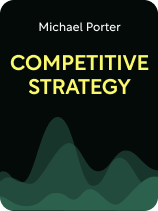

This article is an excerpt from the Shortform book guide to "Competitive Strategy" by Michael Porter. Shortform has the world's best summaries and analyses of books you should be reading.
Like this article? Sign up for a free trial here.
How do you perform competitive market research? How can studying other businesses improve yours?
According to Michael Porter’s book Competitive Strategy, researching your competitors will benefit you in two ways. First, it will enable you to create effective countermoves to their strategies. Second, it will help you anticipate their responses to your strategic initiatives.
Let’s explore the insights you’ll gain by performing competitive market research.
Research Area #1: Competitors’ Objectives
Porter suggests that beginning your competitive market research with your competitors’ objectives helps you ascertain whether they are satisfied with their current performance and market position, which enables you to accurately predict their reactions to shifting market conditions.
- Example: Your competitor’s goal is to acquire a 30% market share. Since they only hold 10%, you can assume that they’re dissatisfied with their performance and will react aggressively to any threats that hinder their growth plans.
Additionally, this line of research helps you identify whether you and your competitors share common objectives or if your objectives differ.
Common objectives: Areas where your goals align with those of your competitors indicate the potential for intense competition in the future. For instance, if multiple competitors plan to expand into a specific market segment simultaneously, they might inadvertently increase competition by targeting the same customer base or devising similar marketing campaigns.
Differing objectives: Areas where your goals diverge from those of your competitors indicate opportunities to capitalize on differentiation. For example, if your competitors aim to offer the cheapest products while you strive to provide the most innovative ones, you can position yourself as a premium brand catering to customers seeking superior products.
| Advice on Researching Competitors’ Objectives Like Porter, many business experts suggest that knowing your competitors’ goals is essential for positioning your business for success. Further, as previously discussed, examining how competitors’ goals may align with your own paves the way for potential alliances that can create mutual benefits. Here are multiple methods you can use to learn more about your competitors’ objectives. Examine your competitors’ annual reports, press releases, investor presentations, and public statements for clues about their strategic objectives, future plans, and performance targets. Keep an eye on your competitors’ job postings and hiring trends for clues about their priorities—such as if they’re investing in specific skill sets or entering new markets. Attend industry trade shows and pay attention to your competitors’ presentations, panel discussions, and announcements to figure out what direction they’re moving toward. Keep track of key personnel changes within your competitors’ organizations to gain insights into new strategic directions—such as changes in leadership or strategic roles. Stay informed about any partnerships or collaborations your competitors enter into, as it can reveal their objectives and potential areas of expansion or specialization. Engage with mutual customers and suppliers to gather insights about your competitors’ priorities. |
Research Area #2: Competitors’ Self-Perceptions and Decisions
Porter explains that researching how your competitors perceive themselves reveals insights into their assumptions and decision-making patterns.
- Example: A competitor that perceives itself as affordable might assume that price is the primary factor influencing purchasing decisions. This assumption influences all its strategic decisions, such as choosing to prioritize cost reduction over innovation.
According to Porter, the insights you gain on your competitors’ decision-making process can reveal specific market needs that they’re overlooking—which, in turn, enables you to position your business effectively in relation to theirs.
Example: Because your competitor prioritizes cost-cutting over innovation, it overlooks customers who value superior quality products. This suggests an opportunity to capitalize on a market gap and avoid direct competition: Position your business as a premium brand that caters to customers seeking high-end products.
| Biases Lead to Missed Opportunities How can understanding competitors’ self-perceptions and decision-making patterns reveal market needs they might overlook? According to psychologists, it provides clues into the biases that might limit their thinking, causing them to miss out on opportunities that they can capitalize on. Some common biases that might hinder a competitor’s ability to identify and address market needs include: Confirmation bias: This bias leads competitors to selectively seek and interpret information that confirms their existing beliefs and perceptions. As a result, they may prioritize certain factors, such as price, while disregarding other important market needs or opportunities. Anchoring bias: Competitors with this bias anchor their decision-making on a specific idea, such as positioning themselves as an affordable option. This limits their ability to consider alternative strategies or approaches, such as prioritizing innovation or emphasizing product quality. Availability bias: Competitors with this bias rely heavily on readily available information or past experiences to form their perceptions. Consequently, they may overlook emerging trends or changes in customer preferences, potentially leaving gaps in addressing specific market needs. |
| Advice on Researching Competitors’ Self-Perceptions Marketing experts recommend the following methods for assessing how your competitors perceive themselves or wish to be perceived: Engage in social listening: Monitor their social media channels, looking for patterns in their messaging, tone of voice, and the language they use to describe their brand, products, and services. Conduct interviews: Reach out to their current or former employees, as well as industry insiders, for insights into their internal culture and values. Attend industry events: Listen to their presentations, paying attention to the language they use and the image they project to gain insights into how they position themselves. Analyze brand aesthetics: Look at their logos, color schemes, taglines, and overall brand messaging to identify how they want customers to perceive them. |
Research Area #3: Competitors’ Current Approaches
According to Porter, researching your competitors’ current approaches reveals how they organize their resources and operational procedures to meet their objectives. This information enables you to monitor and evaluate the effectiveness of their strategies and anticipate potential strategic shifts.
Example: Your competitor prioritizes exceptional customer service, allocating significant resources to ensure customer satisfaction and retention. By monitoring its high customer satisfaction and retention rates, you evaluate the effectiveness of its strategy and predict that it’ll continue to focus on customer-centric approaches to maintain a competitive edge.
| Nine Questions to Uncover Competitors’ Current Approaches Alexander Osterwalder and Yves Pigneur (Business Model Generation) offer an in-depth way to analyze competitors’ current strategies: Ask nine questions to gain insights into their business model: 1) Who are its customers? Define what group of consumers the business targets its product to. For example, if it sells children’s books, it’s probably targeting parents and preschools. Methods for evaluating the effectiveness of its customer targeting strategy include tracking customer feedback and measuring sales in these target segments to assess whether their marketing efforts and content resonate with parents and preschools. 2) What channels does it use to communicate, sell, and distribute its products and services? For example, a business might rely on online advertising, an e-commerce store, and the postal system. Methods for evaluating the effectiveness of its communication, sales, and distribution strategy include tracking and measuring click-through rates, conversion rates, and sales attributed to specific advertising channels. 3) What sort of customer relationships does it establish? For example, it might offer a fully personalized one-on-one service to build customer loyalty. Or, it might offer automated services with no dedicated customer service representatives. Methods for evaluating the effectiveness of its customer relationship strategy include measuring customer churn rates, conducting customer satisfaction surveys, and monitoring customer support interactions for quality and responsiveness. 4) What value does it offer? How does its product or service benefit customers? For example, Smallpdf.com offers free and low-priced pdf services to individuals who don’t want to subscribe to traditional alternatives. Methods for evaluating the effectiveness of its value proposition include tracking subscriber growth, analyzing customer feedback, and monitoring customer engagement metrics. 5) What resources does it rely on? A business needs one or more of the following resources to create and deliver its products to customers: material (for example, specific equipment), monetary, intellectual (for example, copyrights or patents), and human (for example, employees or specialists). Methods for evaluating the effectiveness of its resource strategy include monitoring production costs and analyzing inventory turnover rates. 6) What partnerships does it rely on? There are four types of partnerships a business might rely on: between non-competitors (eBay and Paypal), between competitors (Apple and Microsoft’s patent-licensing agreement), joint alliances (Ford and Toyota develop hybrid trucks), and buyer-supplier alliances (Samsung supplies Apple). Methods for evaluating the effectiveness of its partnership strategy include measuring the impact these partnerships have on market share, revenue growth, and customer satisfaction. 7) What are its core activities? The main tasks that a business needs to focus on to operate successfully fall into at least one of the following three categories: production, troubleshooting, and infrastructure management. Methods for evaluating the effectiveness of its core activities include tracking key performance indicators for the category. For example, for competitors focused on troubleshooting, monitor customer complaints, response times, and resolution rates. 8) How does it make a profit? Does it deal in single transactions or recurring transactions? Does it offer fixed prices or variable prices? Methods for evaluating the effectiveness of its profit model include measuring revenue churn rates and evaluating the pricing strategy’s impact on customer acquisition and retention. 9) What are its costs? Does the business have one-off costs to produce and distribute a product or does it have ongoing costs such as salaries and office rentals? Methods for evaluating the effectiveness of its costs strategy include analyzing financial statements, tracking the cost of goods sold, and monitoring production costs per unit |
Research Area #4: Competitors’ Strengths and Weaknesses
Porter suggests that researching your competitors’ strengths and weaknesses helps you identify two key areas: areas where they have a competitive advantage, potentially posing formidable challenges to your business; and areas where they are vulnerable and that you can take advantage of to gain a competitive edge.
Example: Your competitor has a strong distribution network and loyal customer base, so it will be difficult for you to attract its existing customers. However, it does have a limited online presence, so you can leverage digital marketing strategies to reach the online customers that it’s unable to acquire.
| Advice on Researching Competitors’ Strengths and Weaknesses Like Porter, many business experts suggest that knowing your competitors’ strengths and weaknesses is key to forming a successful business strategy. Here are multiple methods you can use to effectively evaluate your competitors’ strengths and weaknesses. Identify potential vulnerabilities that may not be immediately apparent, such as dependence on a single supplier, compliance issues, or organizational weaknesses. Conduct surveys and interviews to understand the factors that their customers value and where they may fall short. Evaluate customer reviews, online ratings, and social media sentiment to uncover any potential compromises to their brand reputation. Analyze their supply chain management, production processes, logistics, and customer service operations to determine areas of excellence or inefficiency. Assess their research and development efforts, new product launches, and investments in emerging technologies to gauge their ability to innovate and adapt to market needs. Examine their financial statements, debt levels, and cash flow to assess their ability to invest in growth strategies, withstand economic downturns, or respond to unforeseen challenges. |

———End of Preview———
Like what you just read? Read the rest of the world's best book summary and analysis of Michael Porter's "Competitive Strategy" at Shortform.
Here's what you'll find in our full Competitive Strategy summary:
- The groundbreaking book revolutionized the field of strategic management
- A guide for businesses seeking to achieve a competitive advantage
- How to anticipate and understand your competitors' strategies






